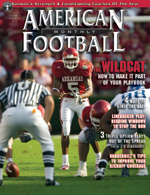Article CategoriesAFM Magazine
|
Linebacker Play-Reading Windows To Stop The Runby: Keith AlbersDefensive Coordinator O’Fallon Township High School, O’Fallon (IL) © More from this issue Stopping the run is always the number one concern of any defense. At O’Fallon Township High School, we have developed a scheme that allows linebackers to make an initial read and attack the ball carrier. We utilize good pursuit angles and have an understanding of the opponent’s blocking scheme that is simple to learn for the players and allows the coach to use the offense’s blocking scheme against them.
|
|
|||||||
| HOME |
MAGAZINE |
SUBSCRIBE | ONLINE COLUMNISTS | COACHING VIDEOS |
Copyright 2025, AmericanFootballMonthly.com
All Rights Reserved





